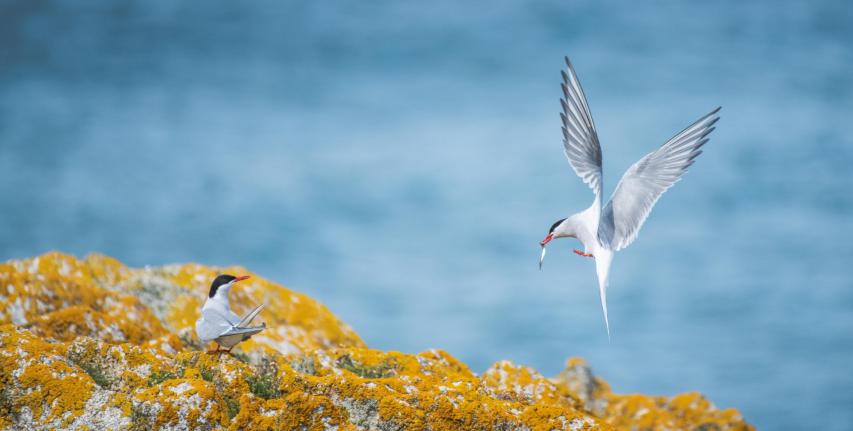Click here to discover the new Dalkey Islands Infographic
Dalkey Islands
Dalkey Islands are significant for their ecology, history, architecture and archaeology as well as for their, social, cultural and historic uses. They are also an important part of the coastal landscape being visible from most parts of Dublin Bay and as far south as Wicklow. The islands attract many visitors and DLR are currently developing a Visitor Management Plan for the islands, in order to ensure the protection of the heritage of the islands including important bird species. We have also developed a Code of Conduct for visitors to the island and this is provided in the Related Documents on this webpage. The islands are designated as an EU Natura 2000 site called a Special Protection Area (
Arctic Terns nest on Dalkey Island for the first time
For the first time on record, Arctic Terns have successfully raised chicks on Dalkey island in 2019, giving a boost to the vulnerable colony.
As terns are a ground nesting bird, the pressures of sea rise, increased storminess, flooding along with predators such as rats and gulls have taken their toll on our tern populations on Dalkey islands. There were great concerns for the future of the dwindling Arctic Tern colony.
Birdwatch Ireland and their volunteers have managed to remove at least a large proportion of the rat population on Dalkey Islands. Canes were also erected across a portion of Lamb Island to exclude gulls from the tern colony. The efforts of Dún Laoghaire Rathdown staff to manage all aspects of the island and the great work of Birdwatch Ireland has assisted the survival of these chicks. This work was carried out as part of the Dalkey Tern Conservation Project, which is currently funded by Dún Laoghaire Rathdown County Council.
Habitats and rare plants
There are a variety of interesting habitats on Dalkey Island and some rare plant species also.Some interesting habitats occur on Dalkey Island including; dry grassland, rock outcrops, wet grassland, dense bracken, sea cliffs, rocky shores, inter-tidal and submerged zones All of these habitats contribute to the unique wild and isolated character of the islands that everyone enjoys. A number of rare plants have been recorded from the grassland on the islands in recent decades, including a set of rare species that are specific to the dry, open, coastal heathland habitat.
DLR have commissioned mapping of Dalkey Islands in 2009 with an updated mapping exercise carried out in 2018. We also run a monitoring programme to check the vegetation and a number of monitoring points have been placed on the island.
A rare plant study was carried out in 2009 – 2010 and that has been updated in 2019. Rare plants have been located and will be monitored on a regular basis. Additional rare plants have been noted in 2019 including Spring Vetch and Frog Rush. Other rare species refound that may have benefited from the drought of 2018 include Sea Storks- bill.
Dalkey Islands Conservation Management Plan 2014 – 2024 was developed for the islands and has provided a list of actions to be implemented including those for biodiversity. These biodiversity actions are been currently undertaken.
Archaeology
Dalkey Island, meaning ‘Thorn Island’, was home to some of the first Stone Age settlers on the east coast of Ireland. There is evidence of activity from the Neolithic and Bronze Periods. Arrowheads, axes and pottery from these periods have been discovered during the archaeological excavations of the island. Uncovered evidence from later periods revealed 5th and 6th Century glass from Belgium and France, English pottery and an 11th Century silver coin from Normandy. There are also signs that the island was once used for farming.
Martello Tower and Gun Battery
The Martello tower on Dalkey Island is one of the most recognizable landmarks on the Dublin coastline. It was built on a high point of the island and was intended to work in tandem with the battery built at the south end of the island to command a vessel’s approach to Dublin Bay and anchorage in Dalkey Sound. The order to build these two fortifcations, dated 30 June 1804, stated that they were intended: ‘For the defence of the Sound, and passage between the Muglins, to keep an enemy’s boats & vessels at a distance and oblige them to work up to fetch the South Bull.’
St. Begnet’s Church And Burial Ground
Saint Begnet’s Church and its burial ground occupy a prominent position overlooking Dalkey Sound. The church, like that in the town of Dalkey, is dedicated to Saint Begnet, (also referred to as Begh or Bee) and is associated with Saint Bea’s Head in Cumberland and Killibeaes in Scotland. The church was partially re-modelled in the early nineteenth century to house by workmen engaged in the construction of the Martello tower and battery. This led to the alteration of window openings and the installation of a fireplace.
For more information on Dalkey Islands please see the Related Documents and Useful Links on this page and the new Dalkey Island Infographic.
We greatly appreciate your support to protect Dalkey Island and its heritage.
We greatly appreciate your support to protect Dalkey Island and its heritage.




